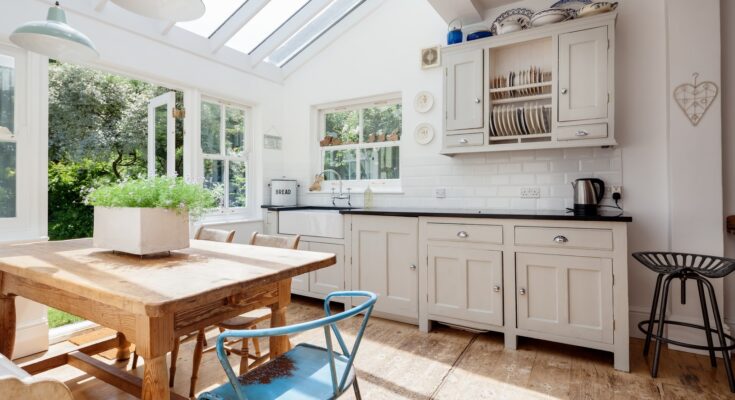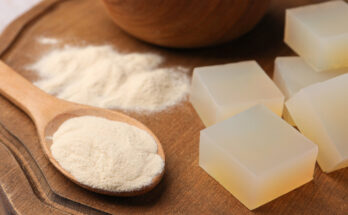Tips And Tricks To Give Your Overly-Modern Kitchen More Vintage Charm
We may receive a commission on purchases made from links.
For the past decade, modern all-white kitchens reigned supreme. After years of yellow oak cabinets and heavy, Tuscan-inspired kitchens, the airy designs felt like a breath of fresh air. People craved a more contemporary look, leaning towards details like glossy cabinet fronts, designs without handles or visible hinges, and graphic elements like using black grout with white subway tiles. However, the tides are changing once again, and these designs now feel strangely sterile. After the upheaval of the pandemic, during which we were forced to stay at home more often and really assess our spaces, people now want cozier, more lived-in rooms that feel more inviting. And they’re creating those spaces by incorporating vintage elements, whether it’s through materials like old wood and stone, or actual antique pieces. While there are a lot of eras that constitute “vintage,” in this piece we will be focusing on the vintage aesthetic that mimics old English kitchens. This fits in with the cottagecore, cozy, and homey look that people are craving right now, where they’re leaning more towards rich colors, heavy textures, and weathered antiques.
The best thing about defrosting your modern kitchen with Old English elements is that you don’t have to invest in a remodel to do so. Instead, you just have to strategically weave in these antique details to soften the look of a starkly contemporary space. Whether that’s swapping out your hardware for something that looks like it was sourced in a flea market or weaving in some strategic knick-knacks, these are simple but effective fixes. Here is how to make your kitchen feel a little older and, as a result, a little more inviting.
Add antique finishes, like copper or unlaquered brass that patinas
One of the easiest ways to add an antique touch to an overly modern kitchen is to infuse the space with antique finishes. Modern kitchens usually focus on airy colors such as crisp whites, stark blacks, and commanding grays. But antique finishes are infused with warmth — just think of the rich and layered patina of unlaquered brass or the sunny hues of copper. And since these finishes are often associated with heritage pieces, they will help add some instant vintage charm to your kitchen.
This is great for people who don’t want to invest too much in big-ticket items, like furniture pieces or rugs (though more on that later.) Instead, you can focus on adding small accessories with these aged finishes. For example, you can add a pot rack over your stove or island and fill it with copper pots. Or for something a little more toned down, add a few copper pots or decorative vessels on the countertop as decor. You can also swap out the modern matte black or silver handles on your cabinets for ones made from unlacquered brass. The ones from Rejuvenation are a designer-favorite and age the more you touch them. You can also swap out your contemporary light switches for something more old-fashioned, such as the viral Forbes & Lomax Toggle Switch. (Or, if you want something more affordable, the similar Knightsbridge Toggle Switch.) If you’re looking for something with a little more impact, you can also try adding copper or brass island pendants, sink faucets, or even small floating shelves.
Add vintage hardware
Your hardware’s finish isn’t the only thing that can give your contemporary kitchen more personality. Its shape and style can also help make it feel more traditional. For instance, if you have simple round knobs on your cabinets or drawers, try swapping them out for pulls with more intricate detailing. Anything that has more flourishes feels a little more artisanal and handmade — and less like it could be mass-produced and found on Amazon. Because of this, it will make your kitchen feel more English-style.
For instance, zero in on old-fashioned designs, like cup pulls, which are commonly found on antique furniture and cabinet pieces. Top Knobs’ Dakota Pull is a great example. If you prefer knobs, look for ones that mimic Victorian designs, which will have raised ring detailing. The Ardell Round Cabinet Knob is a great option. On the other hand, if you like sturdy pulls, choose ones with carvings or extra detail-work, such as the Lake & Loom Brass Handles that have raised notches on the sides and ring details on the handle ends.
If you have exposed hinges, you can also swap them out for something a little more nostalgic, such as butterfly or ball-tip hinges. Both are used for surface-mounted inset cabinet doors, where half of the hinge is on display. For the former, you can choose a true Victorian design, like House of Antique Hardware’s Butterfly Flush Mount Hinge, or something more subdued, like the Country Butterfly Hinge. For the latter, focus on finding a hinge with a pronounced ball-tip so it creates a bigger design impact. Amerock’s Ball Tip Hinge is a great example.
Incorporate vintage furniture in your design
Vintage English kitchens weren’t fitted like our kitchens are today. Rather than having a row of upper and lower cabinets attached to the walls, they instead were outfitted with freestanding furniture like armoires, hutches, plate rails, and work or prep tables rather than boxy kitchen islands. Rather than feeling uniform and cohesive the way a wall of cabinets does, they looked piecemeal and lived-in. The space looked like it was either assembled using unused furniture from around the house or pieced together over the years. So if you want to create a Victorian-inspired kitchen, you should follow suit.
While you likely aren’t about to rip out your kitchen cabinets to make room for freestanding pieces, you can incorporate them into available pockets. For example, do you have an empty wall next to the fridge? Try sourcing an antique China hutch from Facebook Marketplace and filling it with your favorite cookware. If you don’t have any available floor space, see if you can take advantage of any open wall space instead. For example, you can find a vintage dish rack, or if you don’t enjoy thrifting or going to auctions, get one like DHGate’s British-Inspired Arched Plate Rack. If you’re renting and your kitchen didn’t come with a built-in island, you can also invest in a stand-alone prep table, which usually looks like a weathered wooden table with drawers for storage. Such an example is the Erickson Solid Wood Kitchen Island.
Add vintage-inspired curtains to the space — but not just on windows
If you’re looking for fast but effective ways to infuse your space with vintage charm, then don’t overlook the power of curtains. Add delicate lace curtains to the windows or, if you don’t want to obstruct too much of your view or have limited light, add cafe curtains that only take up half of the window pane. If you’re on a budget, you can even DIY cafe curtains to add quaint charm to your space. However, these aren’t your only options — there are a ton of creative places to add them to your kitchen.
For example, you can hang a curtain panel over your dishwasher or microwave niche to hide the modern appliances. This is a popular trend right now and easy to DIY — check out tutorials like the one by OurNHHome, which uses Rod Desyne’s 18- to 24-inch Rod for mounting. If you have some glass-front cabinets, try adding interior curtains to obstruct the view and add a little more charm to your space. No glass cabinets? Consider removing a few lower cabinet doors and replacing them with striped curtains on a tension rod to infuse the room with a European-like touch. You can also add a curtain-like vibe through your lighting, choosing a pendant light draped in fabric to add a touch of coziness.
Add vintage decor all throughout the room
Another affordable and quick way to add some vintage charm to your space is through decor. If you have a modern, all-white kitchen, you can make it feel a little more heritage-inspired by sourcing earthy and old antique accents to make it feel a little less “new.” If you have a very modern kitchen, it would be best if you would source real antiques rather than antique-lookalikes from big box stores to really infuse the space with some old-fashioned charm. For example, while Studio McGee items in Target are vintage-inspired, they still look pretty new and mass-produced, which might not help move the needle very far when trying to infuse your kitchen with true old-English charm. Things with chips, patina, or weathered colors can really help warm up the space and make it feel more lived-in.
And there are so many ways you can go about this. For instance, you can display earthenware dishes on open shelving or glass-fronted cabinets, giving off the impression you use them to plate your meals (even if you’re just using them as decor). You can also display handmade pottery on countertops, focusing on pieces with earthy glazes. The secret to using vintage ceramics as decor is to mix and match them with more modern elements to create a sense of balance — think displaying the handmade collection on a marble tray.
If you have open wall space — like above your breakfast nook or a wall without uppers — consider hanging vintage oil paintings of still lifes or landscapes. And if your space still needs a little extra warmth, put down weathered runners on the floor. All of these details will make your kitchen seem like it has been there for decades.
Swap out your modern lighting for old-fashioned options
Our light fixtures help cinch a theme, so swap out any modern pendants or ambient lighting in favor of vintage designs. If you aim to create an old-English kitchen, it would be best to focus on fixtures with antique finishes (like the aforementioned unlacquered brass or copper), as well as cottage-inspired styles. You’ll be amazed how quickly the space will feel more vintage when there is a stoneware pendant hanging over your breakfast nook or two glass lanterns hanging over your island.
For example, something like the Creative Co-Op Stoneware Pleated Lamp adds warm texture to an all-white kitchen that feels too sterile. It looks like a vintage ruffled plate, adding plenty of charm to the space. If you prefer something less sweet, you can try a pair of dignified brass lanterns, such as the Carrington Hanging Lanterns. They have an aged patina that makes them look like they have been hanging over your island for at least 70 years, making your kitchen seem like it’s been in the family for generations. Or if you would like something softer to smooth out your overly-contemporary kitchen, consider a unique fabric-draped chandelier, complete with ruffles and pleats. These types of lamps are seen in numerous designs in deVol kitchens, which is famous for producing old-English style kitchens today. Such an example is the Handmade ‘Somerset’ 20″ ivory linen ruffle pendant from Maria Marabella Shades.
Display some clutter to make it feel homier
Hiding everything behind cabinets and closed pantries is a rather new setup. The main aim of contemporary kitchens is to create a clutter-free space, with the goal of making the room look less like a kitchen and more like a showpiece. For example, appliances are integrated behind paneling, small gadgets are hidden inside appliance garages for less mess, and countertops are left immaculately empty. While it’s a vibe, if your goal is to add some vintage charm to the space, focus on infusing it with clutter. Old English kitchens keep a lot of stuff on display, so do the same. Just think of some of the elements of old provincial kitchens: glass front cabinets that show off the content inside, plate racks that display your most prized tableware, open shelving that makes things easy to grab, pot racks dangling above stove tops, and utensils in earthenware pots to keep them close at hand — everything is all out in the open.
If you’re looking for quick ways to add clutter, first focus on keeping your most-used items on display. Buy some earthenware containers and put wooden cooking utensils inside them, or hang them from a brass wall-mounted rail. If you go the latter route, you can also hang woven baskets from it and put things like produce or spare dish towels inside. Some more ideas include swapping out your plastic mixing bowls for porcelain or stone ones and leaving them stacked on the counter, or if you have a collection of wooden cutting boards, leave them leaning against your backsplash. If you’re willing to find some permanent ways to display your clutter, consider installing floating shelves, swapping out some of your cabinet doors for glass ones, or hunting down standalone furniture pieces like glass-fronted China cabinets. This will give you plenty of room to put all sorts of vintage pieces on display, from heirloom-quality servingware to charming baking goods.
Add more wood wherever you can
A super easy way to make your modern kitchen feel a little more vintage is to infuse it with more wood. Think of what contemporary kitchens look like — the very modern ones have glossy or laminate cabinet fronts, while others have cool-toned colors like bright white or dark gray. You can tone down these looks with the warm texture of wooden pieces. Old English kitchens are filled with such accents since they largely relied on natural materials. They might have things like wooden beams on the ceiling, butcher block countertops, and a weathered dairy table in the middle of the room used for food prep. While that might not be easily replicated in your own kitchen, you can mimic the vibe of that with plenty of wooden accents dispersed throughout the room.
You can add them in so many ways. For instance, if your island feels too stark, incorporate wooden stools and massive cutting boards for prep work. This will instantly make the space feel earthier. If you have the space, you can also consider adding a small butcher block wheeling table next to the island as extra prep space. As for smaller accents, consider adding raw wooden bowls on the countertop to capture everything from fruit to small decor accents like wooden beads, and invest in wooden vases and vessels to accent floating shelves or the tops of cabinets. If you’re looking for more standout pieces that will give you a bigger pop, swap out your bistro table for a weathered wooden one and get standalone furniture like hutches, spice racks, or dining nook benches.
Add pediments to select cabinets
Pediments are architectural accents found everywhere from the tops of door frames to kitchen cabinets, and they often take on a triangular form. They add a little extra flair to the design, making the space seem more bespoke and designed. They can also create the illusion of higher ceilings since they draws the eye upward, making the space feel larger than it is. Old English kitchens often had pediments on top of their freestanding hutches or cabinets, and if you like the look, you can DIY one to add historic charm to your space. This will only work on cabinets that don’t reach the ceiling, and they often look best when centered on a cabinet row or placed above a standout piece — such as one with open shelves or glass-fronted doors.
This DIY will also work best on painted cabinets, since it’s much easier to color-match your new addition than try to source a similar wood and stain to match your existing finishes. To mimic this design, all you will need to do is create a triangle from wood and then add your choice of trim around it to dress it up. If you have existing crown molding on the top of your cabinets, it’s best to copy that same trim design to make it feel cohesive.


